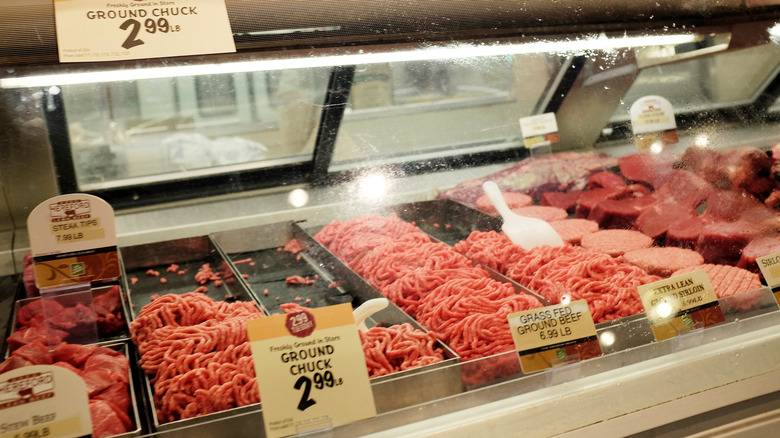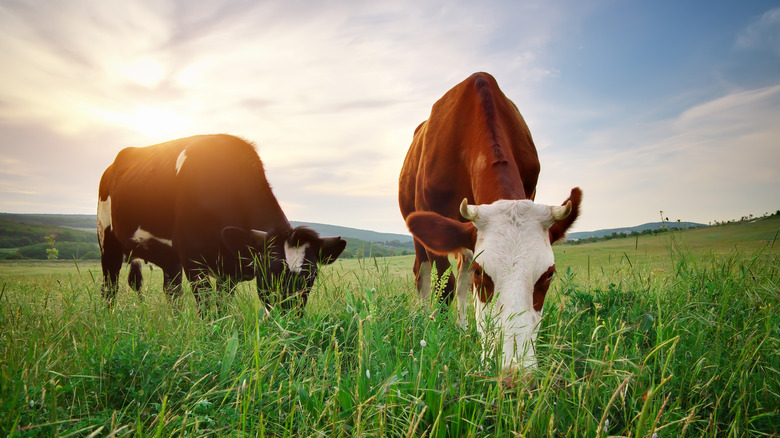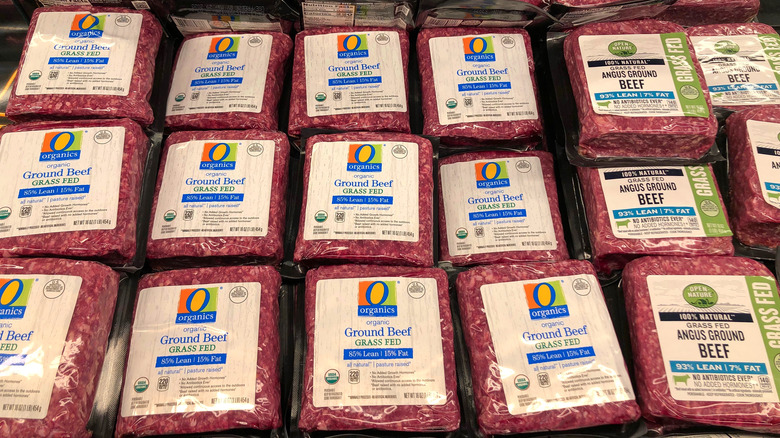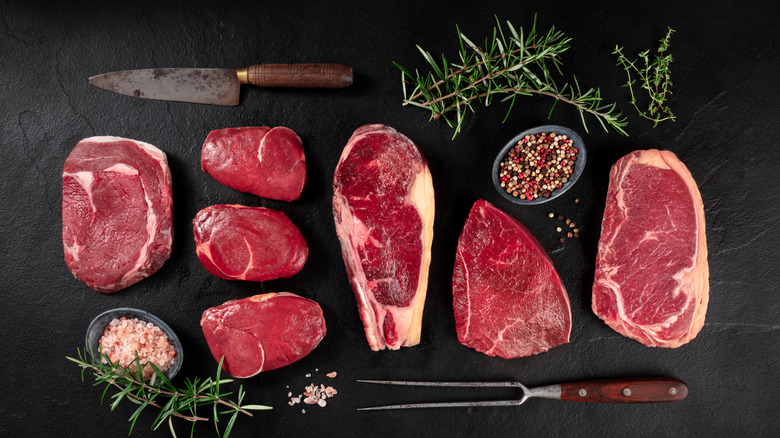Everything You Need To Consider When Buying Ground Beef
It's Friday night and you've got a nice weekend ahead. But you don't want to make a big meal or spend hours standing over a hot stove. Why not whip up some burgers for the family or a tasty meatloaf to fill those stomachs? They're easy to throw together and always a hit. After all, who doesn't love a thick juicy burger? Especially if it has all the fixings and maybe a side of fries? It seems like an easy dinner option, but then you get to the meat counter, and suddenly, you're overwhelmed with all the choices.
Not only are there different cuts of beef, but there are also several different kinds of protein from which to choose. And forget about the fat content. The list goes on and on. With so many choices, how do you know which package of ground beef would make the perfect burger or meatball? And more importantly, which one will taste the best? Is the pricey Wagyu the way to go? Or will your entrée taste just as delicious with the significantly cheaper chuck? We asked Jered Standing, the owner of Standing's Butchery, what he suggests when it comes to choosing the best ground beef for your meal.
Quality is Important
Knowing where your beef comes from is key. Is the cow leading a comfy life roaming freely across grassy meadows or shuffled into a barn with a hundred other cows? Standing believes tastier beef tends to come from farms where the cows can roam free and graze on green grass. Standing says you should "look for pasture-raised, grass-fed, and to a lesser degree, organic."
Organic seems to be the buzzword that we all search for these days. Standing warns that "organic can be (sometimes intentionally) misleading, however. That certification doesn't say much about how the animal was raised, and it still could have been fed a lot of grain, which is bad for cows." In fact, according to Standing, this grain could just be organic and "farmers spending the time and money to get the organic certification are probably doing all the other stuff right too, but it's not guaranteed."
Think about what the animal eats
What a cow eats is just as important as how its raised. Is it eating lots of grains from troughs with several other cows, or is it roaming and grazing on various types of grass? According to Healthline, what a cow eats directly relates to the beef's composition. A cow that consumes mainly corn and soy tends to produce a fattier piece of meat. On the other hand, a cow that eats different grasses and plants tends to produce leaner meat containing more fatty acids (Omega-3s and CLA are full of health benefits).
But since we're eating beef, does what a cow eats affect the flavor? Standing says it does. "Grass-fed beef will have more complexity of flavor. With grain-fed beef, all of the flavor comes from the fat, so it can be kind of one-note compared to a grass-fed animal raised on a pasture eating different types of grasses at different times of the year."
Don't judge ground beef by its color
Have you ever gone to the store determined to buy a pound or two of ground beef, but some of the meat is grey in color? You assume it's bad, right? Not necessarily. Turns out that dark purple meat is probably fine. The USDA says that if the beef hasn't been exposed to outside air, it will actually be a dark burgundy color. It's not until it's exposed to the elements that the meat turns bright red. Then after it's been in the fridge for a few days, that's when it starts to turn brown. Standing states, "this darkening is due to oxidation, the chemical changes in myoglobin due to the oxygen content." And it's totally normal.
Standing agrees that the color of the meat doesn't necessarily mean it's gone bad. "Ground beef will change color really quickly when deprived of oxygen. This is why sometimes the outside will look really red, but the meat is dark inside," Standing said. "The color change itself doesn't affect the flavor." Still unsure if that darker package of ground beef will be safe to eat? "Trust your nose," Standing said. "Color can be deceiving, but the smell test will always work."
The more fat the better
If you've ever looked at a display case full of ground beef, you've probably noticed packages with various ratios stamped on them. There are lean packages with 5-10% fat and those with as much as 20%. While you might be tempted to pick the low-fat option, fat is more important than you realize. Ground beef with a higher fat content may mean more calories, but it also means better flavor thanks to all those fatty acids we mentioned earlier (via Bio Med Central).
Unfortunately, sometimes that fat ends up at the bottom of the pan, which is why Standing prefers higher fat for burgers and leaner beef for sauces. "You can never go wrong with an 80/20 or 80/15 fat content," declares Standing. "The only time I might go leaner is when making a meat sauce because you end up with a lot of the fat just floating on top if your grind is too fatty."
However, when it comes to burgers, Standing prefers the opposite. "If I'm making burgers, bump it all the way up to 70/30. Burgers will usually be cooked very hot and very fast," Standing said. "So most of that fat will stay in the burger rather than rendering out. And fat is delicious. This fatty richness can be (and often is) balanced by something acidic like pickles, mustard, tomato, etc."
Skip the Waygu
There are so many trendy types of beef available these days from Angus to Argentine and Kobe to Waygu. These cows are bred everywhere from Scotland to Spain and Argentina to Japan, and their meat usually comes with a hefty price tag: up to $200 per pound. Why is it so expensive? The way the cows are raised usually leads to the massive amounts of fat marbling within the muscle. That marbling creates a more tender, flavorful piece of meat.
While that tenderness may make a difference when ordering the perfect steak, does it really matter when you're buying ground beef? The owner of Standings Butchery doesn't think so. "Wagyu is a breed known and sought after for its marbling, so for ground beef, it makes no difference," Standing said. "Except for the fact that Wagyu is almost always fed a lot of grain to increase that marbling fast, so it's often really bland tasting because the animal was very young and had a diet with very little variety."
The type of grind matters
While fattiness, color, and type of beef are all important factors to consider when choosing the best ground beef, the type of grind is just as important but often overlooked. How can a grind be that important? Believe it or not, not all grinds are the same. One grind might be perfect for a meatball, while another grind might be better suited for a Bolognese. So, how do you choose?
Start by deciding what you're going to make. Most meat grinders come with a variety of different-sized grinding plates: fine, medium, coarse, and even very coarse. No matter which size you choose, you'll end up with a very nice ground beef. According to Standing, "the standard medium grind you'll find anywhere is versatile and works for everything." However, Standing occasionally changes his grind choice. "The only time I might want a more coarse grind is for chili," he said. The meat will stick together better with a coarser grind, meaning you'll end up with a chunkier texture, exactly what you want in a rich, hearty chili.
Consider adding other meats to the mix
Ground beef is the most obvious choice when it comes to burgers. But for meatballs or a hearty meat sauce, consider adding another ground meat to your mix. Mixing your proteins not only adds fat which we've established adds flavor, but it also adds texture which makes for a more interesting mouthfeel and a better eating experience. Standing agrees but only for certain meats. "I'm a burger purist and don't really want to mix other proteins into my beef," he said. "But the meatballs we make at Standing's are a pork and beef mix, and I would do the same for sauces and chili."
While pork and beef make a better chili and beef and lamb a better kofta, Standing doesn't think all proteins mix well. "I'm less likely to mix sausage with ground beef because of the very different textures," he notes.
Even though a meat mixture makes for a more interesting and potentially flavorful meal, it's not your only option. You could also add beans, oats, or even mushrooms for a more engaging eating experience. Each of these additions brings a different benefit: they all add different flavors, but some add more vitamins while others add moisture and tenderness.
Store your beef properly
Once you've picked out the perfect pound of ground beef, you have a few options: You can make an amazing meal with it right away, you could toss it in the fridge and use it in the next day or two, or you can drop it in the freezer and ostensibly forget about it. (Come on, we've all done it.) If you don't have any plans for the beef immediately, Standing says to store it in the refrigerator or freezer. But for how long? "If ground beef is vacuum sealed, it's good for one week in the fridge and forever in the freezer," Standing said. "If it's not vacuum sealed, only 1-2 days in the fridge and 3-4 weeks frozen." Freezing is the best option, though, because if you follow Standing's advice, the beef will keep for a while.
But wherever you keep it, make sure it's sealed properly. Meat sealed incorrectly is a very common mistake people make when freezing their meat. Oxygen is the enemy of ground beef; if it's packaged incorrectly, air could seep in and ruin that delicious protein. Or, as Standing simply states, "the less air contact, the better." If air does find a way in, best case scenario, you get a little freezer burn. Worst case, the meat goes bad entirely.
Pick the right cut
If you want your ground beef to be as fresh as possible, head to a butcher shop and have them grind it right there on the spot. Just make sure you pick the best cut. While all parts of the cow can be ground up and turned into hamburger, Standing reveals "harder working muscles with lots of connective tissue and collagen make for tastier ground beef." What would he choose if you came into his shop and asked? "Chuck and Short Rib are my top choices," he admits.
Chuck comes from the shoulder of the cow and usually contains a large amount of fat which Standing mentioned adds flavor. The short rib, on the other hand, can be found below the rib plate next to the shoulder. This placement gives the meat not only a ton of fat marbling from both the rib plate and shoulder but also a ton of beefy flavor often associated with the chuck. No matter which of these cuts you choose, you'll end up with one tasty hamburger.
Save money, buy in bulk
With the rising cost of food these days, one way to save some money is to buy in bulk. Stores like Costco or Big Lots often have a meat department where you can buy large packages of ground beef. While it's a great way to buy a lot of food at discounted prices, the one thing to keep in mind is storing it. As we mentioned, how you store the meat will affect how long it lasts and the flavor. So, the best thing to do if you're going to buy big is to portion the meat out as soon as you get home.
Since the American Cancer Society says a healthy portion of meat is about three or four ounces, one pound of ground beef would easily serve a family of four, which means that a three or four-pound Costco package can just as easily be divided into three or four separate one-pound bags. Then, roll a rolling pin over the meat to flatten it out and seal it. Now not only have you gotten rid of most of that evil air, but those zip-lock bags can also be stacked on top of each other, leaving you plenty of space in your freezer for your favorite frozen vegetable or quart of ice cream.










